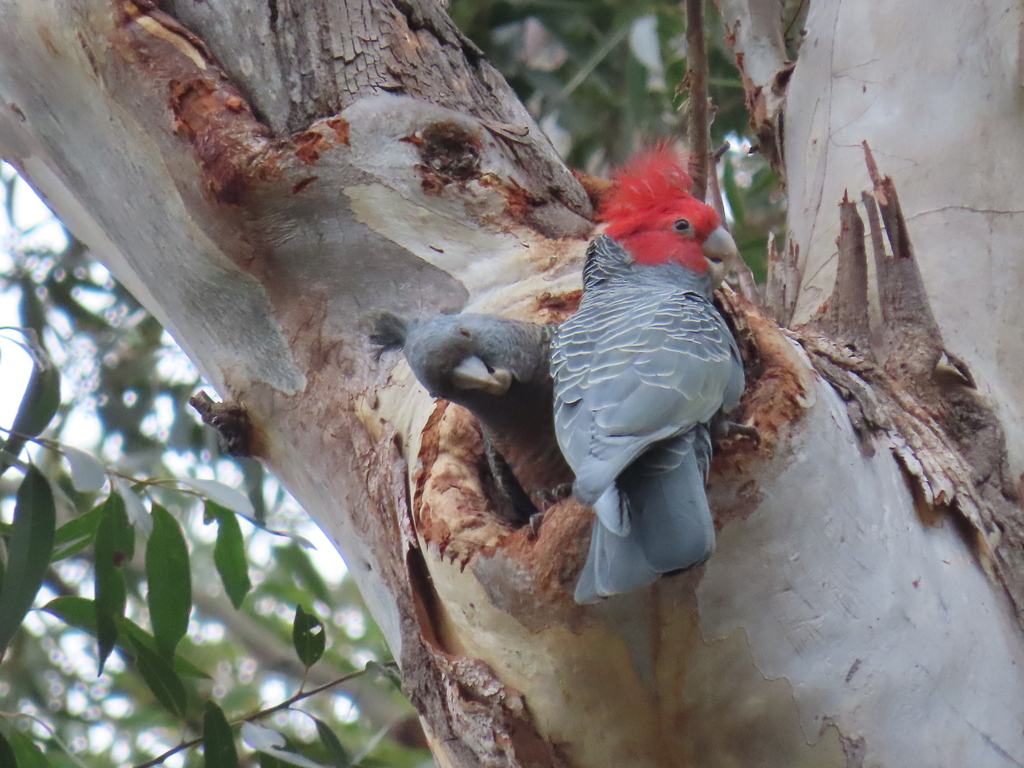Love is in the air for our local Gang-gang Cockatoos! Pairs start searching for their breeding hollows in August through to September. The scarlet red of the male’s wispy crest and their stocky grey silhouettes distinguish these loveable cockies from other bird species.
Gang-gang Cockatoos, or gang gangs suffered terribly in the Black Summer bushfires, with 23% of their core habitat burnt, and scientists estimate that 10% of them were killed outright either during or in the aftermath of these horrifying landscape-scale fires.
These gentle, cool climate forest and woodland specialists were already declining in numbers before Black Summer so when it came time to review the status of the species they were listed as Nationally Endangered under the EPBC Act. The listing came into effect March 2022.

A pair inspect a hollow by Murramarg in Inaturalist ( link below)
I wrote about gang gangs in Australian BirdLife Magazine in 2021 and one of the most useful sources of information came from wildlife biologist, Michael Mulvaney, who along with a band of dedicated citizen scientists and ornithologists have been tracking the fate of Canberra’s gang gangs for some years.
Michael and his team found that Canberran gang gangs were finding life tough with intense competition for breeding hollows, nest predation of the chicks by hungry possums and sadly the death of fledgling chicks during heat wave events!
Their detailed studies are now referenced in the new Conservation Advice for the species, helping us to see where the greatest threats lay.
Mulvaney and his team have continued their intensive monitoring of gang gang breeding hollow, and their studies have extended into other parts of the parrots’ range of SE Australia including the Wombat Forest! And this is where YOU come in!
If you think you have a breeding hollow for Gang-gang Cockatoos let me know and I can pass your details onto Gayle Osborne at Wombat Forestcare who is liaising with Michael on this important project.
OR– why not join the wonderful citizen science platform iNaturalist and record your sightings there? Michael is looking for any activity of Gang-gangs looking into, entering, leaving or within a hollow. Also of interest is any mating observed or where Gang-gangs are chewing bark around a hollow.
The list of threats facing our adorable gang gangs is long and rather sad. What is clear is that gang gangs need our help right now – and amassing information on the challenges they face while breeding is a vital part of this process.
Even if you don’t have nest trees you can help our local Gang-Gang Cockatoos:
- Retain large old trees with hollows.
- Lobby for action on climate change – altered rainfall patterns and increased heatwaves are a severe and increasing threat.
- Support Wombat Forestcare’s campaign against Vicforests who are degrading a key breeding hotspot for this species: the wonderful Wombat Forest.
For a great series of photos of a pair of Gang-gang Cockatoos inspecting a hollow, see https://inaturalist.ala.org.au/observations/132791733
0 Comments